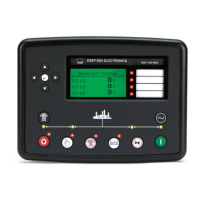Check Sync During the synchronising process, the controller will adjust the frequency of the generator to
closely match the existing bus.
Typically the oncoming set will be adjusted to be 0.1Hz faster than the existing supply.
This causes the phase of the two supplies to change continuously.
Before the breaker can be closed, the following conditions must be met:
• The difference between the two supplies frequencies must be between the Check
Sync Low Frequency and Check Sync High Frequency
• The difference between the two supplies voltages must be equal to or below the
Check Sync Voltage
• The phase of the two supplies must be equal to or below the Check Sync Phase
Angle
Dead Bus The bus is measured when the set is to be loaded. If the bus is measured to be below the
Dead Bus Voltage, the bus is assumed to be ‘dead’ and the breaker can be closed
immediately.
If the bus is measured to be above the Dead Bus Voltage, the oncoming generator must be
synchronised before the breaker can be closed.
Fail to sync Alarm
If the synchronising process continues longer that the Fail to Sync Alarm Delay, the alarm is
triggered.
This may occur if changes in the load are making the set control difficult due to changes in
voltage and frequency.
Electrical Trip : The set is stopped. In a Load Demand scheme, other generators may start
if available.
Warning: The set continues to synchronise.

